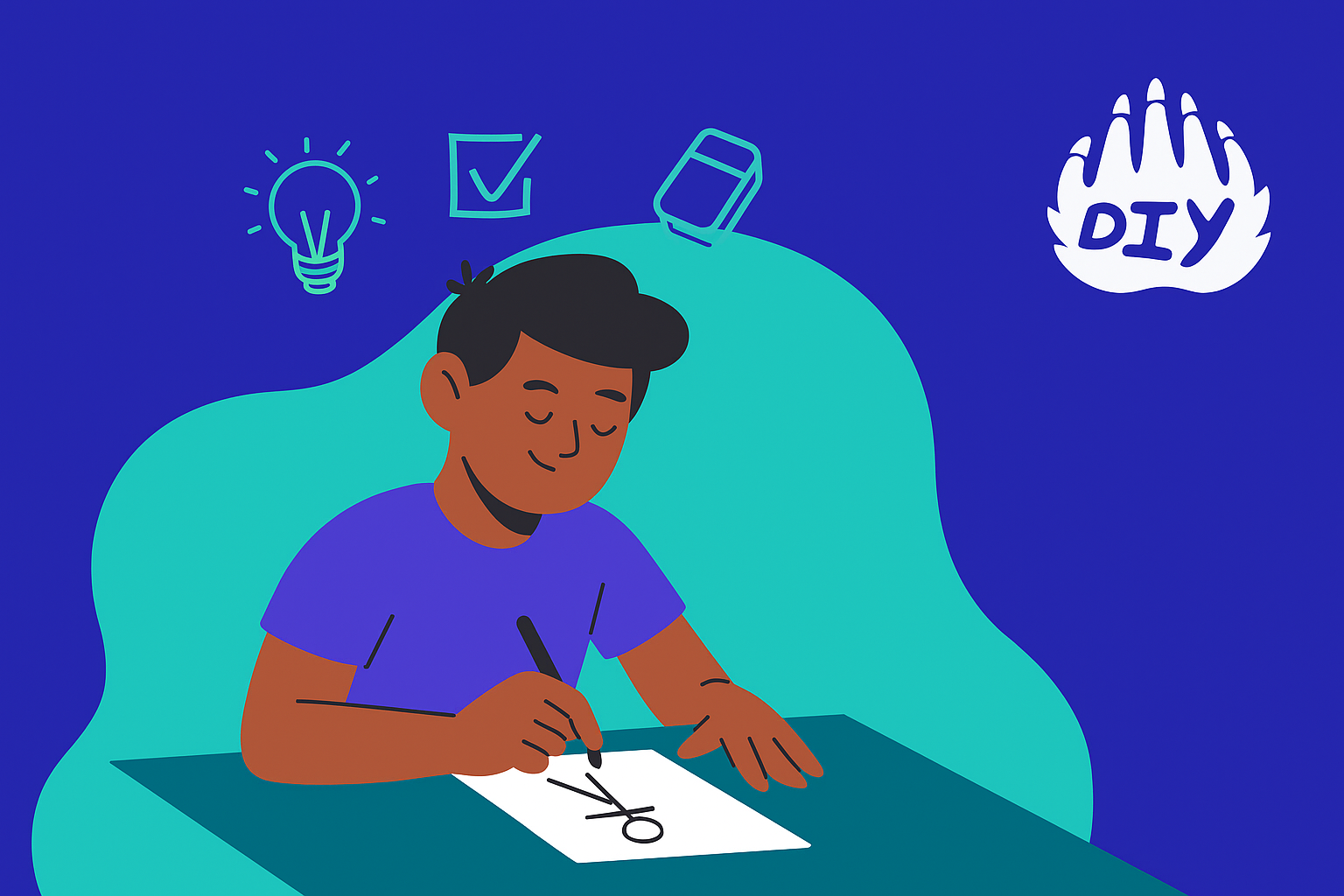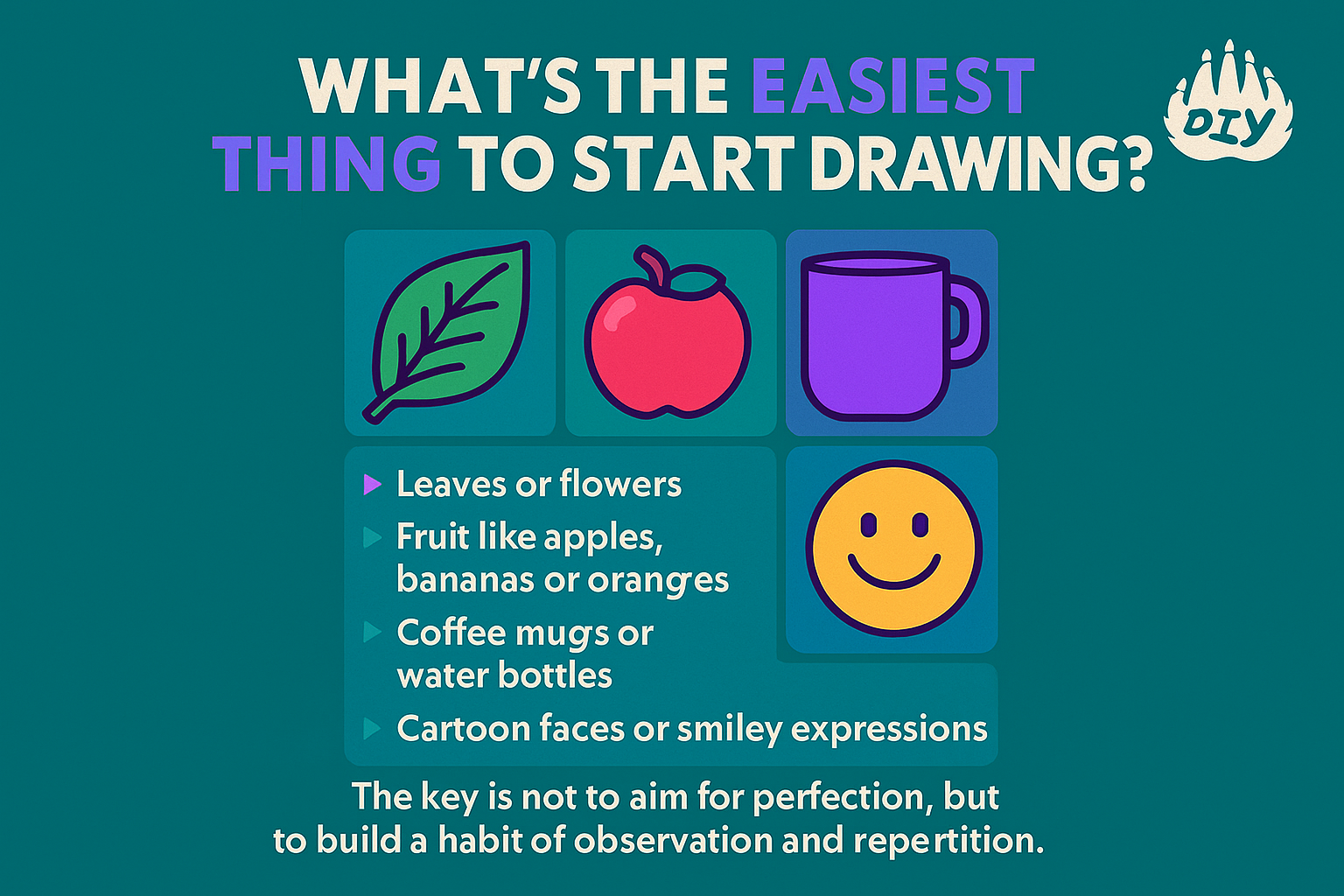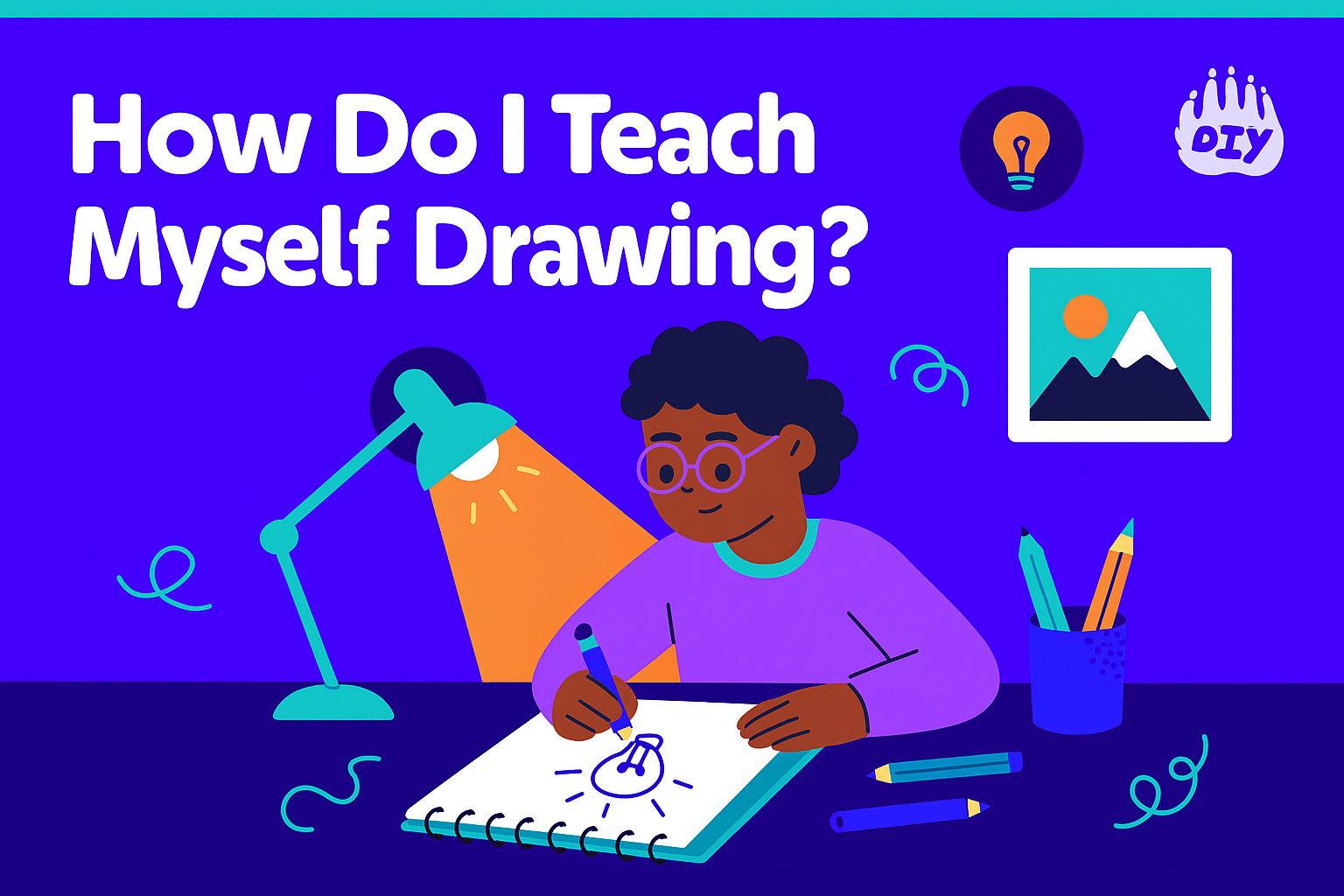Unlock your inner artist even if you've never picked up a pencil before.
Learning how to draw can feel intimidating, especially if you’ve never tried it before. But here’s the truth: you don’t need to be born with talent to become good at drawing. With the right mindset, practice techniques, and tools, anyone can learn how to draw from home, at their own pace.
Whether you're sketching stick figures or dreaming of realistic portraits, this beginner’s guide along with resources like DIY’s How to Draw tutorials will walk you through everything you need to know to start drawing confidently, even if you’re teaching yourself from scratch.

1. Can You Train Yourself to Draw?
Yes. Many people believe that drawing is something you're either born good actor you're not. But that’s a myth.
Drawing is a Learnable Skill.
Like playing the guitar or learning a new language, drawing is a skill you can build over time. You don’t need to attend art school to improve. All you need is consistent practice and a willingness to learn.
In fact, thousands of artists around the world are completely self-taught. They started with stick figures, doodles, or scribbles then got better by studying the basics and drawing every day.
If you're wondering “Can I really teach myself to draw?” The answer is a resounding yes. But here’s what helps:
➣ Start small. Don't aim for perfect drawings right away
➣ Be consistent. Even 10 minutes a day adds up
➣ Embrace mistakes. Every bad sketch teaches you something
➣ Celebrate progress. Look back at your first drawings after a few weeks you’ll see growth!
2. Where Should You Start?
If you’re just beginning your drawing journey, it’s completely normal to wonder, “Where do I even start?” The good news is, you don’t need expensive tools or formal training to get going. Start simple, build confidence, and focus on consistency.

What’s the Easiest Thing to Start Drawing?
When you're brand new to drawing, the easiest subjects to draw are basic shapes and everyday objects. Think circles, squares, apples, cups, or even your hand. These simple sketches train your eye to observe and your hand to follow.
Some beginner-friendly ideas include:
➣ Leaves or flowers
➣ Fruit like apples, bananas, or oranges
➣ Coffee mugs or water bottles
➣ Cartoon faces or smiley expressions
The key is not to aim for perfection, but to build a habit of observation and repetition.
Basic Drawing Materials You’ll Need
You don’t need fancy supplies to begin. In fact, many professional artists started with the basics. Here’s what you need to get started:
➣ Pencil (HB or 2B is great for general sketching)
➣ Paper (any sketchbook or printer paper works)
➣ Eraser (preferably a kneaded eraser or soft rubber one)
➣ Sharpener (to keep lines crisp)
Simple Warm-Up Exercises for Beginners
Before diving into full drawings, warm up your hand with simple exercises to build control and hand-eye coordination:
➣ Draw lines and curves in different directions
➣ Sketch rows of circles, squares, and triangles
➣ Practice shading gradients from dark to light
➣ Try contour drawing by tracing outlines of objects without lifting your pencil
These might seem basic, but they lay the foundation for more complex drawing skills down the road.
Daily Practice Tips to Build Muscle Memory
Just like any other skill, drawing improves with practice. You don’t need hours each day just 15 to 20 minutes consistently can lead to major progress.
Here are a few tips to keep your momentum:
➣ Set a daily sketch goal (like one small object or doodle a day)
➣ Keep a “no-pressure” sketchbook just for practice
➣ Repeat exercises like lines, shapes, and shadows weekly
➣ Reflect on your old sketches to see your growth over time
The more often you draw, the more natural it feels. Muscle memory builds silently, turning shaky lines into confident strokes over time.
3. Foundational Drawing Skills to Master
Once you've warmed up and built a daily drawing habit, it’s time to strengthen the core skills that help you draw like an artist. These aren’t advanced techniques they're essential fundamentals that form the building blocks of every great drawing.

How to Draw Like an Artist: Observation, Form & Light
The key to realistic drawing is learning to see like an artist. Instead of drawing what you think an object looks like, start observing its:
➣ Shape: What basic forms make it up?
➣ Edges: Are they soft, sharp, curved, or broken?
➣ Light and shadow: Where is the light hitting, and where are the dark areas?
Observation trains your brain to translate 3D objects into 2D shapes on paper.
Practice with Common Objects and Still Life
You don’t need models or complex scenes. Start with:
➣ Mugs, vases, fruits (classic still life objects)
➣ Your hands or feet (always available, great for anatomy)
➣ Shoes, keys, or even your phone (to understand form and texture)
Practicing these helps you see shape, light, and space more clearly in everyday life.
4. How to Draw and Think Like a True Artist
Drawing is visual problem-solving. The more you practice, the more your brain and eyes sync up to interpret what you're seeing. You’ll begin to notice shapes, shadows, and proportions even when you’re not drawing.
Imagination vs. Realism in Drawing
There’s no right answer some artists focus on realistic detail, others lean into creative expression. Both require understanding of the basics. Even the most stylized art relies on form, proportion, and light.
Try both:
➣ Draw real objects for structure
➣ Add imaginative elements (like fantasy creatures or surreal details) to build creativity
Using Negative Space and Composition
Negative space is the area around your subject. Paying attention to it helps balance your drawings and avoid common sizing mistakes. Good composition also helps guide the viewer’s eye and creates visual impact.
➣ The importance of visual thinking
➣ Tips on developing your artistic perspective
➣ The role of imagination vs. realism
➣ Using negative space and composition in your sketches
5. How Do We Draw a Girl or a Boy?
People are one of the most popular and challenging subjects to draw. The good news? You can break it down into simple steps, starting with proportion and basic shapes.
While there’s a lot of overlap in drawing boys and girls, here are a few beginner pointers:
➣ Boys tend to have broader shoulders, squarer jaws, and shorter hair (though not always!)
➣ Girls often have narrower chins, softer lines, and longer lashes or hair
That said, style and personality matter more than strict anatomy so use these as loose guides, not rules.
How to Draw a Face of a Girl / How Do You Draw a Boy’s Face?
Start with a circle and divide it with a vertical and horizontal guideline:
1. Eyes sit halfway down the head
2. Nose is halfway between eyes and chin
3. Lips go halfway between nose and chin
4. Ears line up with eyes and nose
From there, adjust the jawline, eyebrows, and hairstyle to reflect age, gender, or style.
6. How to Draw Realistic Features
One of the most satisfying milestones for any beginner is drawing a realistic face. Eyes and lips, in particular, bring your portraits to life but they’re also tricky to get right. With the right techniques, though, you can master them step by step.
How to Draw a Realistic Eye (Step-by-Step)
1. Start with an almond shape for the outline
2. Add the iris and pupil remember, the iris is a perfect circle but is partially covered by the lids
3. Sketch the tear duct and waterline
4. Add the upper and lower eyelids
5. Lightly shade the white of the eye (it’s never pure white!)
6. Layer shadows and highlights around the eye socket
7. Draw lashes with quick, curved strokes not straight lines
How to Draw Lips Step by Step
1. Start with a horizontal guideline
2. Mark the width of the lips and center
3. Draw the upper lip (M-shape) and bottom lip (U-shape)
4. Shade the upper lip slightly darker it's usually in shadow
5. Use soft shading to show the volume of the bottom lip
6. Blend gently to avoid harsh outlines
Avoid drawing a single line between the lips; instead, use shading to suggest a natural separation.
7. How to Draw Hair for Beginners
Hair is often overwhelming because it’s made up of thousands of strands but you don’t need to draw each one. Instead, focus on shape, flow, and lighting.
Techniques for Straight, Curly, and Wavy Hair
➣ Straight hair: Flows in smooth, long strokes. Use varied pressure for realistic texture
➣ Curly hair: Built from loops and spirals. Draw in sections and layer curls
➣ Wavy hair: Use S-shaped curves and follow the natural bounce of the waves
Practice each style separately to understand their unique rhythm and movement.
Common Beginner Drawing Questions Answered
If you’re just starting to learn how to draw, you probably have a few questions and maybe even some doubts. Here are clear answers to help you move forward with confidence:
How Long Does It Take to Get Good at Drawing?
This is one of the most asked questions by beginners. The truth? It depends on your goals and consistency. You can see noticeable improvement in a few weeks if you draw regularly even just 15 minutes a day.
Becoming truly skilled may take months or years, but don’t let that intimidate you. Progress in drawing is often gradual but incredibly rewarding.
Can I Draw Every Day If I Only Have 10 Minutes?
Yes! Even 10 minutes a day makes a difference—especially for building muscle memory and hand-eye coordination. Quick sketch sessions, gesture drawings, or shading practice all add up over time.
Consistency matters more than duration. A short daily habit beats long but infrequent drawing sessions.
How Do I Stop Being Afraid of the Blank Page?
Blank page anxiety is real—but totally normal. Try these tricks:
➣ Start with random marks or shapes to break the ice
➣ Use a drawing prompt or reference photo to guide you
➣ Remind yourself: This is practice, not a masterpiece
➣ Keep a “messy” sketchbook where you’re free to fail
The goal is to draw something, not something perfect.
How Do I Make My Drawings Look More Professional?
Want your art to look more polished? Here’s what helps:
➣ Pay attention to proportions and light source
➣ Use clean lines or blend your shading smoothly
➣ Add a background or context to the subject
➣ Keep your values (light/dark) well balanced
➣ Take a break and return with fresh eyes to refine details
Remember, even small tweaks can elevate a sketch from “okay” to “wow.”
Embrace the Drawing Journey
Learning to draw isn’t a race it’s a creative journey. You’ll have messy pages, off days, and sketches that don’t turn out the way you imagined. That’s all part of the process.
Encourage Self-Compassion and Perseverance. Don’t compare your Day 1 to someone else’s Year 5, Celebrate small wins, like improved line control or realistic shading, Keep your early drawings they’re proof of how far you’ve come.
Take photos or notes as you improve. Over time, you’ll see how much your skills have grown. And remember:
Drawing isn’t about perfection it’s about expression.
So pick up your pencil, make that first mark, and enjoy the act of creating.

